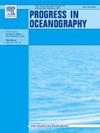黑潮及其邻近水域中层浮游生物和鱼类浮游生物的营养源和途径比较
IF 3.8
3区 地球科学
Q1 OCEANOGRAPHY
引用次数: 0
摘要
具有重要商业价值的鱼类在黑潮中度过其脆弱的早期生命阶段,因此,即使在低营养条件下猎物供应不足的附近,渔业产量也很高。然而,关于鱼类浮游生物如何在复杂的食物网中获得营养动力学支持的信息却很少。在此,我们根据对中生浮游生物和鱼类浮游生物主要分类群的肠道 DNA 含量的代谢编码分析,探索了黑潮及其邻近水域鱼类浮游生物的营养源和营养途径。结果发现,桡足类是最主要和最经常出现的猎物,而非甲壳类则是大多数中生浮游动物和鱼类的次要猎物。以肠道 DNA 含量为基础的营养网络表明,桡足类是最重要的部分,其猎物和捕食者之间存在多种联系,胶状和非甲壳类中浮游动物是次要部分。这些发现表明,钙类是鱼类浮游生物营养途径的重要枢纽,而胶状和非甲壳类中浮游生物群则加强了与多个组成部分的营养关系。与一般观点相反,我们的代谢编码分析表明,黑潮及其邻近水域中鱼类浮游生物的营养动力学并不强烈依赖于放牧食物链,而是得到了多种营养途径的支持。本文章由计算机程序翻译,如有差异,请以英文原文为准。
Comparison of the trophic sources and pathways of mesozooplankton and ichthyoplankton in the Kuroshio current and its neighboring waters
Commercially important fish spend their vulnerable early life stages in the Kuroshio Current, resulting in high fishery production even in the vicinity of poor prey availability under oligotrophic conditions. Nevertheless, little information is available on how ichthyoplankton are supported by trophodynamics in complicated food webs. Here, we have explored trophic sources and pathways toward ichthyoplankton in the Kuroshio and its neighboring waters based on metabarcoding analysis of gut DNA content for major taxonomic groups of mesozooplankton and ichthyoplankton. Calanoids were found to be the most predominant and frequently appearing prey, whereas non-crustaceans were the secondary prey for most mesozooplankton and ichthyoplankton groups. Trophic networks based on gut DNA content demonstrated that calanoids were the most important sector with multiple linkages among their prey and predators, and gelatinous and non-crustacean mesozooplankton were the secondary sectors. These findings suggest that calanoids are important hubs of trophic pathways toward ichthyoplankton, and that gelatinous and non-crustacean mesozooplankton groups strengthen trophic relationships with multiple components. Contrary to general thought, our metabarcoding analysis has revealed that trophodynamics toward ichthyoplankton are not strongly dependent on the grazing food chain, but are supported by multiple trophic pathways in the Kuroshio and its neighboring waters.
求助全文
通过发布文献求助,成功后即可免费获取论文全文。
去求助
来源期刊

Progress in Oceanography
地学-海洋学
CiteScore
7.20
自引率
4.90%
发文量
138
审稿时长
3 months
期刊介绍:
Progress in Oceanography publishes the longer, more comprehensive papers that most oceanographers feel are necessary, on occasion, to do justice to their work. Contributions are generally either a review of an aspect of oceanography or a treatise on an expanding oceanographic subject. The articles cover the entire spectrum of disciplines within the science of oceanography. Occasionally volumes are devoted to collections of papers and conference proceedings of exceptional interest. Essential reading for all oceanographers.
 求助内容:
求助内容: 应助结果提醒方式:
应助结果提醒方式:


